If you’ve been craving sweet bread but are concerned about the calories, you’ve come to the right place. In this section, we will uncover the truth about the calorie content of sweet bread and explore its nutritional value. Sweet bread is a delicious and moist type of bread that tastes like cinnamon raisin bread. It can be enjoyed on its own or paired with spreads like cashew spread or nut butter. The key ingredient in sweet bread is psyllium husk, which makes it moist and soft. Psyllium husk is a fiber that can absorb water and has various health benefits.
Key Takeaways:
- Sweet bread is a popular bread variety that has a moist texture and tastes like cinnamon raisin bread.
- The key ingredient in sweet bread is psyllium husk, which adds moisture and has health benefits.
- Psyllium husk is a fiber that can absorb water and promote digestive health.
- Sweet bread can be enjoyed on its own or paired with spreads like cashew spread or nut butter.
- Understanding the calorie content of sweet bread is crucial for those who are mindful of their calorie intake.
Understanding the Nutritional Value of Sweet Bread
Before we delve into the calorie content, let’s take a closer look at the overall nutritional value of sweet bread. Sweet bread is not only a tasty treat but also provides some essential nutrients that can contribute to a balanced diet.
Sweet bread is typically made with ingredients like flour, sugar, eggs, and butter, which provide a good amount of carbohydrates, proteins, and fats. These macronutrients are vital for energy production and maintaining a healthy metabolism. Additionally, sweet bread contains a variety of vitamins and minerals, including vitamin B6, vitamin E, iron, and zinc.
One of the main ingredients of sweet bread, psyllium husk, is also rich in dietary fiber. Fiber is essential for promoting digestive health and can help regulate cholesterol levels and control blood sugar levels. Including fiber-rich foods like sweet bread in your diet can support a healthy digestive system and aid in weight management.
| Nutrition Facts | Serving Size: 1 slice (40g) |
|---|---|
| Calories | 160 |
| Total Fat | 5g |
| Carbohydrates | 25g |
| Protein | 3g |
| Dietary Fiber | 2g |
Did you know? Sweet bread can be a versatile option for those with dietary restrictions. You can find gluten-free and vegan variations that are just as delicious and nutritious as traditional sweet bread. So everyone can enjoy the goodness of sweet bread without any compromise!
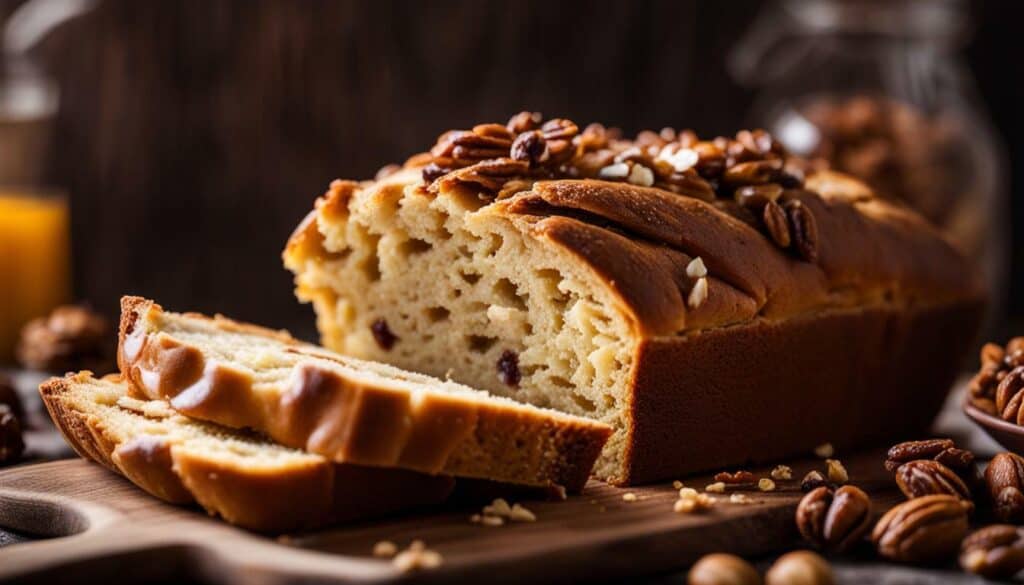
In the next section, we will explore the exact calorie count of sweet bread and discuss how it can fit into a balanced diet. Stay tuned!
Unveiling the Calorie Count of Sweet Bread
Now, let’s address the burning question: how many calories are in a slice of sweet bread? The calorie count of sweet bread can vary depending on the specific recipe and ingredients used. On average, a single slice of sweet bread contains around 150-200 calories. However, it’s important to note that these numbers are approximate and can vary based on portion size and other factors.
To get a more accurate calorie count, you can use a sweet bread calorie calculator, which takes into account the specific ingredients and quantities used in the recipe. This can be especially helpful if you are following a strict calorie-controlled diet or tracking your daily calorie intake.
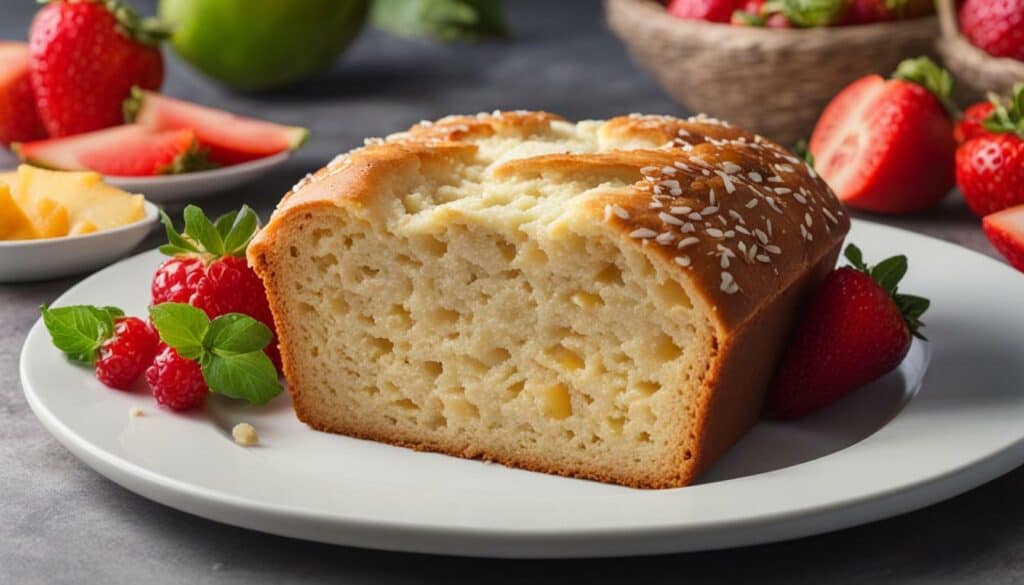
When enjoying sweet bread, it’s also important to consider the serving size. A smaller portion will naturally have fewer calories compared to a larger slice. It’s all about finding the right balance that fits into your overall daily calorie goals.
In summary, sweet bread can be a delicious treat that can be enjoyed in moderation. With an average calorie count of around 150-200 per slice, it can be a satisfying and indulgent addition to your diet. Just be mindful of portion sizes and consider using a calorie calculator to help you stay on track.
Finding Healthy Options for Sweet Bread
Don’t fret! There are plenty of healthy options and alternatives available for sweet bread lovers. If you’re looking to cut back on calories or incorporate more nutritious ingredients into your sweet bread, here are some ideas to consider:
- Swap out refined flour for whole wheat flour: Whole wheat flour is higher in fiber and nutrients compared to refined flour. It adds a nutty flavor and a denser texture to your sweet bread. You can use it as a 1:1 replacement for refined flour in your favorite recipes.
- Include fruits and vegetables: Boost the nutritional value of your sweet bread by adding fruits or vegetables. Some great options include grated carrots, mashed bananas, or shredded zucchini. These additions not only add moisture but also provide vitamins and minerals.
- Experiment with alternative sweeteners: Instead of using refined sugars, try using natural sweeteners like honey, maple syrup, or dates. These options provide a touch of sweetness while offering additional nutrients.
- Incorporate healthy fats: Consider adding healthy fats like avocado, coconut oil, or almond butter to your sweet bread. These fats not only contribute to the moistness of the bread but also provide essential fatty acids.
Remember, moderation is key when enjoying sweet bread, even when using healthier alternatives. Balance your overall calorie intake and consider portion sizes to maintain a well-rounded diet. Here’s a table summarizing the key differences between traditional sweet bread and some healthier options:
| Sweet Bread | Healthy Option 1 | Healthy Option 2 |
|---|---|---|
| Refined flour | Whole wheat flour | Almond flour |
| Sugar | Honey | Stevia |
| Butter | Coconut oil | Avocado |
| Low in fiber | Higher in fiber | Higher in fiber |
Remember, you can always get creative in the kitchen and tweak recipes to suit your taste preferences and dietary needs. With these healthier options, you can continue to enjoy the deliciousness of sweet bread without compromising on your health goals.
Try this Low-Calorie Sweet Bread Recipe
If you’re looking for a low-calorie sweet bread option, give this recipe a try:
- Ingredients:
- 1 cup whole wheat flour
- 1/2 cup unsweetened applesauce
- 2 ripe bananas, mashed
- 1/4 cup honey
- 1/4 cup almond milk
- 1 teaspoon vanilla extract
- 1 teaspoon cinnamon
- 1/2 teaspoon baking powder
- 1/2 teaspoon baking soda
- 1/4 teaspoon salt
- Instructions:
- Preheat the oven to 350°F (175°C). Grease a loaf pan.
- In a large bowl, combine the mashed bananas, applesauce, honey, almond milk, and vanilla extract.
- In a separate bowl, whisk together the whole wheat flour, cinnamon, baking powder, baking soda, and salt.
- Add the dry ingredients to the wet ingredients and mix until just combined.
- Pour the batter into the greased loaf pan. Bake for 45-50 minutes or until a toothpick inserted into the center comes out clean.
- Allow the bread to cool before slicing and serving.
This recipe is a nutritious and delicious alternative to traditional sweet bread. It’s packed with fiber from the whole wheat flour and natural sweetness from the bananas and honey.
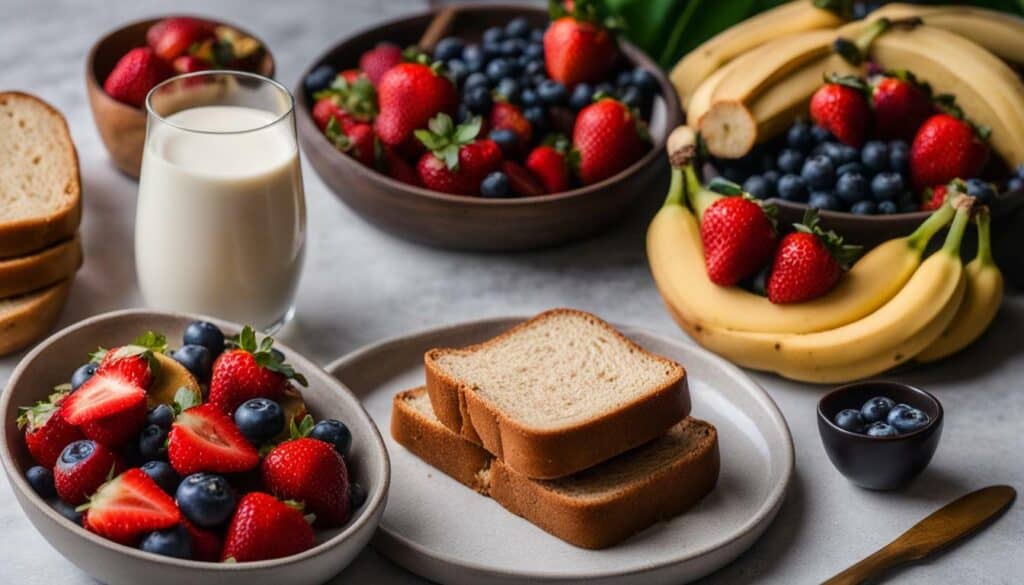
Understanding the proper serving size of sweet bread is essential for managing your calorie intake. While it may be tempting to indulge in a larger portion, it’s important to be mindful of the calories you consume. The serving size of sweet bread can vary depending on the recipe and individual preferences, but it generally ranges from 1 to 2 slices.
According to nutrition experts, a serving size of sweet bread is typically around 1 ounce or 28 grams. This equates to approximately 1 slice of commercially prepared sweet bread. However, it’s important to note that homemade sweet bread may vary in size and weight. To ensure accuracy, you can use a food scale to measure the exact serving size.
Controlling your portion size can help you maintain a balanced diet and prevent overeating. By enjoying sweet bread in moderation and being mindful of your serving size, you can still savor its delicious flavors without consuming excessive calories. Remember to pair your sweet bread with nutrient-rich accompaniments, such as fresh fruits or protein-rich spreads, to enhance its nutritional value.

Table: Nutritional Composition of Sweet Bread (per serving size)
| Nutrient | Amount per Serving |
|---|---|
| Calories | 150-200 |
| Total Fat | 5-8 grams |
| Carbohydrates | 20-25 grams |
| Protein | 3-5 grams |
| Fiber | 2-3 grams |
| Sugar | 5-8 grams |
It’s important to be aware of the nutritional composition of sweet bread to make informed dietary choices. While the calorie count may vary based on the recipe and serving size, a typical serving of sweet bread contains around 150-200 calories. Additionally, sweet bread is a source of carbohydrates, providing energy for your body, along with a small amount of fat, protein, fiber, and sugar.
By understanding the proper serving size and the nutritional value of sweet bread, you can incorporate it into your diet in a healthy and balanced way. Remember, moderation is key, and it’s always beneficial to consult with a registered dietitian or healthcare professional for personalized dietary advice.
Exploring the Origins of Sweet Bread
Sweet bread has a rich and intriguing history that dates back centuries. Its origins can be traced to ancient civilizations, where bread-making was not only a culinary practice but also a cultural tradition. Throughout history, different cultures have developed their own unique versions of sweet bread, each with its own distinct flavors and ingredients.
One notable example is the panettone, a traditional Italian sweet bread that is typically enjoyed during the holiday season. Legend has it that the panettone was first created in the 15th century by a Milanese nobleman who fell in love with a baker’s daughter. To win her heart, he disguised himself as a baker and invented the panettone, a bread enriched with butter, eggs, and dried fruits. Today, panettone is a beloved Italian delicacy that is enjoyed around the world.
“The panettone is not just a bread, it’s a symbol of love and passion,” says Chef Roberto, an Italian pastry chef. “It represents the joy of sharing food and celebrating with loved ones.”
Sweet bread also has a strong presence in Mexican cuisine, particularly during festive occasions like Day of the Dead. One popular variety is the traditional Mexican sweet bread known as “pan de muerto.” This bread, adorned with bone-shaped decorations, is believed to honor and nourish the souls of departed loved ones.
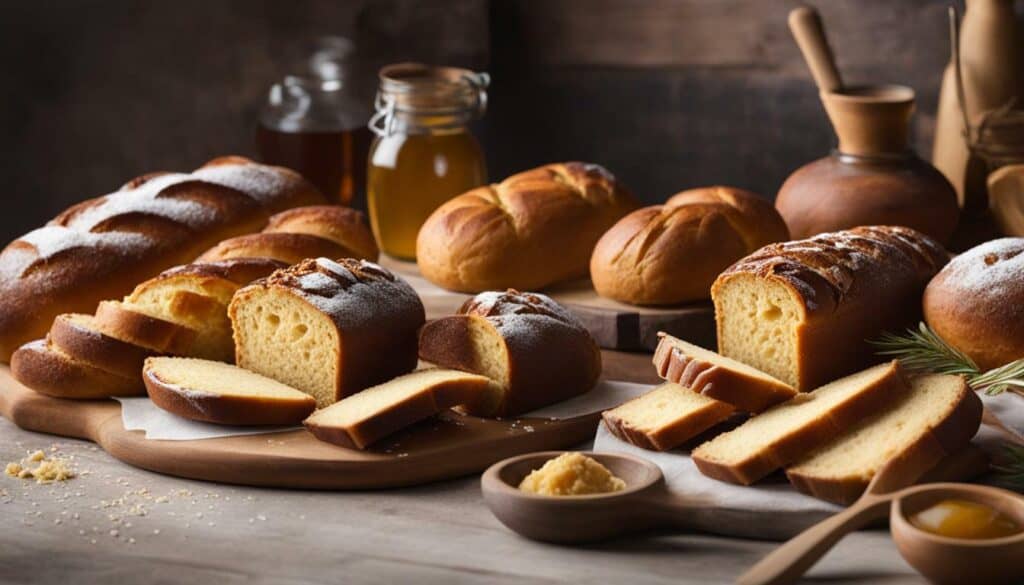
The Symbolism of Sweet Bread
The significance of sweet bread extends beyond its delicious taste and cultural traditions. It has come to symbolize nourishment, creativity, and the importance of sharing food with others.
“Sweet bread represents the bond between family and friends,” says Maria, a culinary historian. “It’s about gathering around the table, breaking bread together, and creating lasting memories.”
Whether you’re enjoying a slice of panettone during the holiday season or savoring a piece of Mexican sweet bread during a festive celebration, the rich history and symbolism of sweet bread adds an extra layer of enjoyment to this delectable treat.
The Significance of Bread in Ancient Times
Bread played a significant role in ancient civilizations, representing both the basic necessity of life and the celebration of special moments. The process of bread-making in ancient times was an essential and time-consuming task. The cultivation of wheat and the milling of seeds into flour required hard work and skill. Dough had to be carefully prepared and shaped before being baked into loaves of bread.
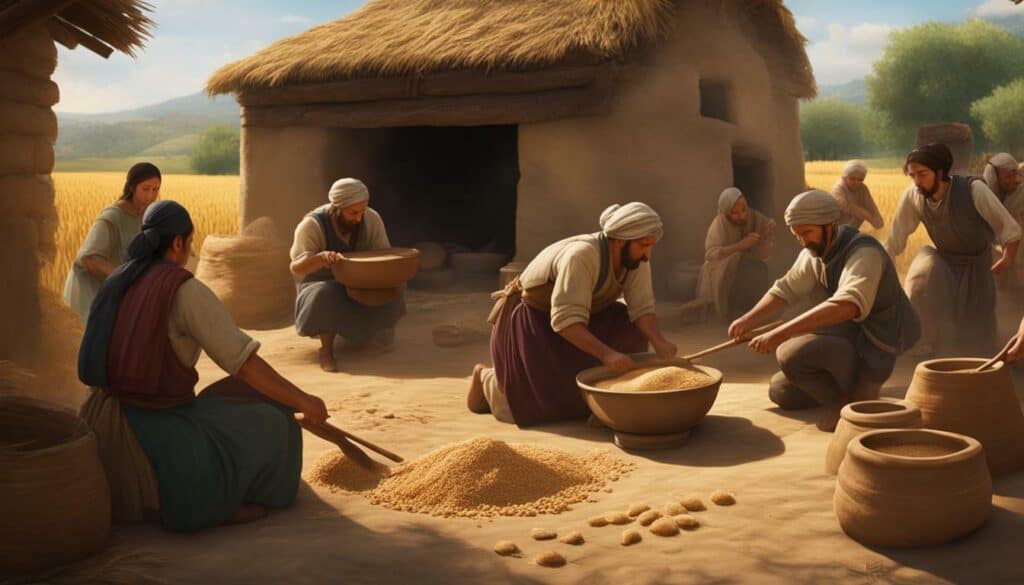
“In ancient cultures, bread-making was not merely a means of sustenance, but also a cultural symbol of creativity and community.”
In ancient Egypt, for example, bread was considered a staple food and a vital source of sustenance for the population. It was often offered to the gods as a religious offering, emphasizing its significance in both daily life and spiritual practices.
Bread as a Symbol of Creativity and Community
The art of bread-making was not limited to Egypt alone. In ancient Greece, bread-making was highly regarded, and bakers were respected members of society. Greek mythology even includes a deity named Demeter, the goddess of grain and agriculture, showcasing the cultural importance of bread in ancient Greek society.
The Romans also valued bread as a staple food. It played a crucial role in the diet of soldiers and civilians alike. The Roman tradition of breaking bread together symbolized unity and friendship. It was believed that sharing bread at the dinner table brought good fortune and strengthened social bonds.
Bread-making was a labor-intensive process, requiring the collective effort of the community. Ancient cultures cherished bread not only for its nourishing qualities but also for its ability to bring people together. From the grinding of grains to the communal act of breaking bread, the significance of bread in ancient times speaks to its role as a central element of daily life and cultural traditions.
| Ancient Culture | Symbolic Significance of Bread |
|---|---|
| Egypt | Staple food, religious offering |
| Greece | Cultural significance, goddess of grain |
| Rome | Unity, friendship, good fortune |
Bread and the Last Supper
The Last Supper holds profound symbolic meaning, with bread and wine at the center of this momentous event. Bread, in particular, plays a significant role in various religious rituals and practices, representing nourishment, sustenance, and spiritual connection.
In the biblical narrative, Jesus broke bread and shared it with his disciples during the Last Supper, expressing unity and the act of giving. This act of breaking bread symbolized his impending sacrifice and the sharing of his body with his followers.
“And he took bread, gave thanks and broke it, and gave it to them, saying, ‘This is my body given for you; do this in remembrance of me.’” – Luke 22:19
Throughout history, bread has consistently held deep cultural and religious significance. In many ancient civilizations, bread-making was considered an essential skill, encompassing both practical and spiritual aspects. The process of cultivating wheat, grinding it into flour, and baking it into bread required time, effort, and expertise.
As an enduring symbol of nourishment and sacrifice, bread continues to hold a prominent place in religious ceremonies and traditions today. Whether it’s the Eucharistic bread in Christianity or the matzah during Passover in Judaism, bread remains a testament to the importance of sustenance and communal sharing.
The Symbolic Meaning of Bread and Wine
The act of breaking bread and sharing wine during the Last Supper represents the core tenets of Christianity. The bread symbolizes the body of Christ, while the wine represents his blood. Together, they embody the spiritual nourishment and eternal life offered through Jesus’ sacrifice.
As believers partake in the sacrament of communion, the consumption of bread and wine serves as a reminder of their faith and the unity of the Christian community. It is a tangible expression of their connection to Christ and a reaffirmation of his teachings.
Through bread and wine, the Last Supper serves as a powerful symbol of redemption, love, and the everlasting bond between Jesus and his disciples. It is a reminder of the transformative power of faith and the enduring significance of this sacred meal.
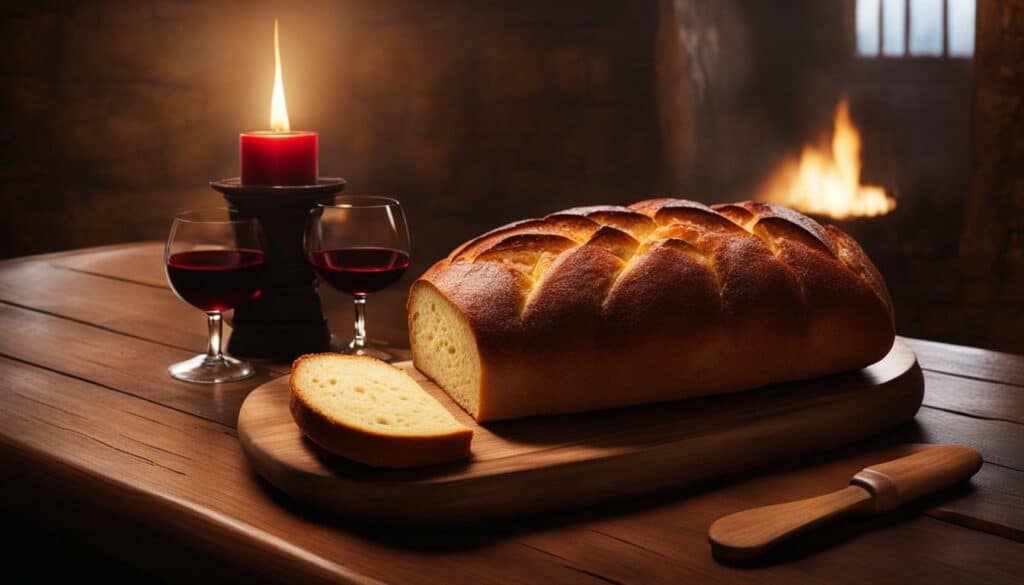
Bread has become synonymous with everyday life, representing sustenance, comfort, and routine. It is a staple food in many cultures, providing nourishment and a sense of familiarity. From the simple act of breaking bread at the dinner table to the aroma of freshly baked loaves filling the air, bread holds a special place in our daily lives.
Throughout history, bread has been a symbol of sustenance and survival. In ancient times, the process of bread-making was labor-intensive and time-consuming. Wheat had to be harvested, seeds had to be milled into flour, and dough had to be made before the bread could be baked. This intricate process required skill, patience, and creativity, reflecting the dedication and hard work that went into providing sustenance for oneself and their community.
As our lives have become more fast-paced and convenience-oriented, bread continues to play a vital role in our routines. It is a versatile food that can be enjoyed in numerous forms – from sandwiches and toast to rolls and baguettes. Bread provides comfort and familiarity in our daily meals, whether we are enjoying a simple sandwich for lunch or using it to mop up the last bits of a delicious dinner.
Furthermore, bread often holds cultural and symbolic significance. In various traditions and rituals, bread is used to symbolize abundance, hospitality, and unity. It is a common sight in religious ceremonies and celebrations, where it represents the sharing of sustenance and the coming together of individuals. Bread’s ability to nourish and bring people together is a testament to its integral role in our everyday lives.
A Brief History of Bread
Historians trace the origins of bread back to the Neolithic era, around 10,000 BCE, when humans transitioned from a nomadic lifestyle to settled agricultural communities. With the discovery of farming, grains such as wheat, barley, and rye became staple crops, leading to the development of bread-making techniques.
Since then, bread has evolved and adapted across various cultures, with each region embracing its unique flavors and techniques. From the baguettes of France to the naan of India, bread reflects the diversity and culinary heritage of different societies.
Today, bread remains an essential part of our daily lives, nourishing us physically and emotionally. Whether it’s a warm slice of homemade bread or a crusty roll from the local bakery, the simple act of breaking bread continues to bring us comfort and a sense of connection to our roots.
| Benefits of Bread as a Staple Food | |
|---|---|
| Nutritional Value | Bread is a good source of carbohydrates, which provide energy for our bodies. It also contains essential nutrients such as fiber, B vitamins, iron, and magnesium. |
| Versatility | Bread can be enjoyed in various forms and styles, catering to different tastes and dietary preferences. From whole grain to gluten-free options, there is a bread for everyone. |
| Convenience | Bread is readily available and easy to incorporate into meals. It can be used as a base for sandwiches, as a side to complement soups and salads, or as a vessel for delicious spreads and toppings. |
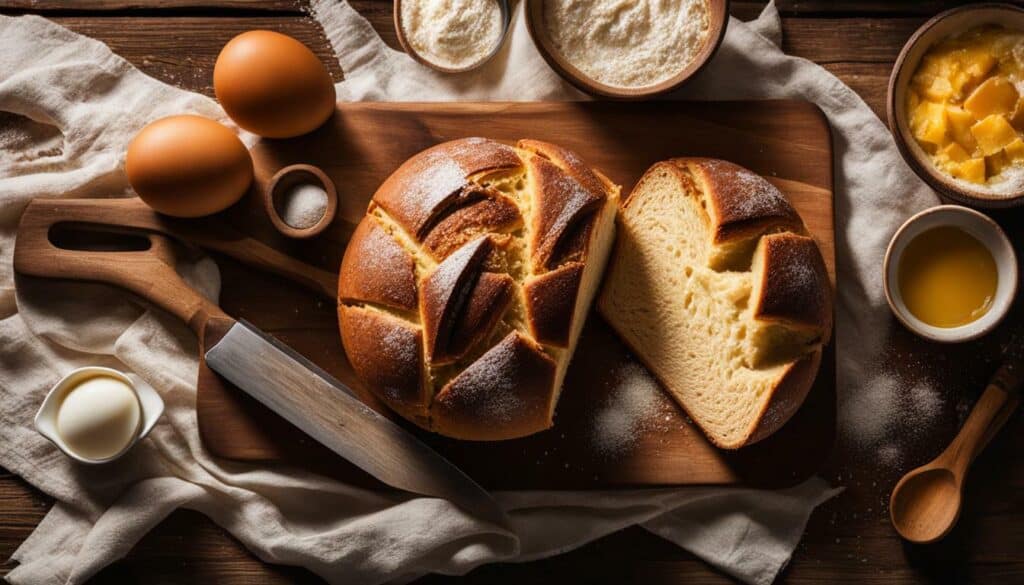
As we reflect on the role of bread in our lives, let us appreciate its rich history, diverse cultural significance, and the simple joy it brings to our everyday routines. Bread’s representation of sustenance, comfort, and routine reminds us of the importance of nourishment and the connections we forge through the sharing of food.
Conclusion
In summary, sweet bread can be a delicious treat without compromising your health goals when enjoyed responsibly. The nutritional value of sweet bread lies in its key components, such as psyllium husk, which adds moisture and fiber to the bread. Psyllium husk has numerous health benefits, including aiding digestion and promoting heart health.
For those who are more conscious of their calorie intake, there are also healthier alternatives available. The life-changing loaf of bread, for example, is a gluten-free and vegan option that is packed with nutrients like sunflower seeds, flax seeds, rolled oats, and psyllium seed husks. This bread is high in fiber and protein, making it a nutritious choice that can be enjoyed as toast.
It’s fascinating to think about the long history of bread-making and its symbolic significance. In ancient times, bread was a staple food that required a labor-intensive process, from harvesting wheat to kneading dough. The choice of bread and wine for the Last Supper by Jesus symbolized the hard work and creativity that goes into making food, as well as the representation of nourishment, sacrifice, and celebration.
Bread continues to symbolize the ordinary and essential aspects of daily life across various cultures. It is a food that brings people together, whether it’s sharing a loaf at the dinner table or enjoying a slice of sweet bread as a treat. So, go ahead and indulge in a slice of sweet bread, savoring its delicious taste and the cultural significance it carries.
FAQ
Q: What is sweet bread?
A: Sweet bread is a delicious and moist type of bread that tastes like cinnamon raisin bread. It is made with key ingredients like psyllium husk, which gives it its soft and moist texture.
Q: What are the nutritional benefits of sweet bread?
A: Sweet bread contains psyllium husk, a fiber that has various health benefits. It is also a good source of carbohydrates, providing energy for the body.
Q: How many calories are in sweet bread?
A: The exact calorie count of sweet bread can vary depending on the recipe and serving size. However, on average, sweet bread typically contains around 100-150 calories per slice.
Q: Are there healthier alternatives to sweet bread?
A: Yes, there are healthier alternatives to sweet bread available. You can try making low-calorie sweet bread recipes using alternative flours and sweeteners, or opt for gluten-free and vegan bread options.
Q: What is the appropriate serving size for sweet bread?
A: The appropriate serving size for sweet bread is typically one slice. However, it is important to consider your individual dietary needs and goals.
Q: What is the history and cultural significance of sweet bread?
A: Sweet bread has a rich history and cultural significance in various cuisines around the world. It has been enjoyed for centuries and is often associated with celebrations and special occasions.
Q: Why was bread-making important in ancient times?
A: Bread-making was an essential and time-consuming process in ancient times. It involved harvesting wheat, milling it into flour, and making dough before baking the bread. Bread represented sustenance, creativity, and cultural traditions.
Q: What is the symbolic meaning of bread in the Last Supper?
A: In the Last Supper, Jesus chose bread and wine to symbolize nourishment, sacrifice, and celebration. Bread represented the ordinary, everyday life, while wine represented joy and celebration.
Q: How does bread symbolize everyday life?
A: Bread has come to symbolize the ordinary and essential aspects of daily life in many cultures. It is often considered a staple food and plays a vital role in meals and gatherings.
How Many Calories Does Cinnamon Bread Have Compared to Sweet Bread?
The calories in cinnamon bread revealed are significantly lower compared to sweet bread. While both are delicious options, cinnamon bread often contains fewer calories due to its inclusion of cinnamon as a flavoring agent. So, if you’re watching your calorie intake, cinnamon bread can be a better choice to satisfy your sweet cravings.





Leave a Reply